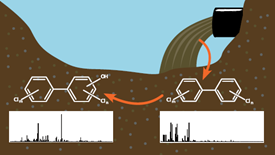Hot Off the Press
The Superfund Research Program (SRP) regularly highlights basic and applied research and activities from the program that span multiple disciplines.
Research Briefs
Study Sheds Light on Breakdown Products of PCBs in the Environment
University of Iowa SRP Center researchers, led by center director Keri Hornbuckle, Ph.D., discovered toxic breakdown products of polychlorinated biphenyls (PCBs) in contaminated sediments at proportionally higher levels than found in commercial PCB mixtures.
Protein Provides Insight into Repiratory Toxicity of Cadmium
A protein called fibrinogen can be an indicator of cadmium exposure in people with chronic obstructive pulmonary disease, according to a study led by Veena Antony, M.D., director of the University of Alabama, Birmingham SRP Center.
Sampling Device May Predict Methylmercury Accumulation in Wetlands
SRP-funded researchers, led by Heileen Hsu-Kim, Ph.D., of the Duke University SRP Center, showed that a small plastic sampling device can efficiently predict the potential for methylmercury - an environmental contaminant - to form in freshwater wetlands and to accumulate in organisms living there.
NIEHS Environmental Factor ArticlesPrenatal exposure to chemical mixtures worsens working memory in adolescents, according to NIEHS-funded researchers at the Harvard SRP Center.

Materials science and bacteria are key to remediation, experts say
During recent SRP Progress in Research webinars, grantees discussed innovative strategies for bioremediation - the process of using bacteria, fungi, and plants to break down contaminants.
In mice, prenatal exposure to polychlorinated biphenyls altered DNA methylation in both the placenta and fetal brain in a manner consistent with neurodevelopmental disorders. DNA methylation is a molecular mechanism that regulates the function and expression of genes. The study was funded in part through the University of Iowa SRP Center.
Extramural Paper of the Month: Tropical cyclones linked to rise in U.S. deaths
Over the last three decades, tropical cyclones in the U.S. were associated with higher death rates in subsequent months, according to a study funded in part through the Columbia SRP Center. This is the first study to evaluate cause-specific mortality risks from tropical cyclones in the entire U.S. population.
EHP at 50 - Keeping Pace with Evolving Science
Throughout 50 years of publishing cutting-edge research and news, Environmental Health Perspectives has evolved to keep up with the times. SRP grantees have contributed substantially to the journal over the years. To celebrate this milestone, SRP shared some SRP-funded studies published in the journal over the years on Twitter, @SRP_NIEHS . Follow #EHP50 on twitter to join the conversation.

PFAS Water Filter Developed Through NIEHS Funding
SRP-funded small business CycloPure, Inc., developed a new filter cartridge compatible with Brita pitchers that can remove per- and polyfluoroalkyl substances (PFAS) from drinking water. The Purefast cartridges are based on CycloPure's DEXSORB+ technology, which uses renewable cup-shaped cyclodextrins, derived from corn starch, to bind and remove all 40 PFAS targeted in the U.S. Environmental Protection Agency PFAS Roadmap.
Researchers at the Northeastern University SRP Center used a data-mining approach to identify a diverse set of chemicals that may contribute to disparities in preterm birth among different populations. According to the authors, results suggest that exposure to an array of chemicals contributes to racial disparities in preterm birth.
Extramural Paper of the Month: Pine Needles Work as Passive Samplers for PFAS
North Carolina State University SRP Center researchers showed that pine needles can be used as a tool to monitor the presence and distribution of PFAS over time. The pine needle's waxy coating traps pollutants in air, including PFAS, providing a record of contamination. More than 70 different PFAS were identified in the pine needles. The types of PFAS detected in samples correlated with known changes in PFAS use over time.
Long-term exposure to polychlorinated biphenyl (PCB) mixtures characteristic of school air may affect the nervous and immune systems, according to an SRP-funded study in rats. Led by researchers at the University of Iowa SRP Center, the study shows that 45.5 micrograms per cubic meter may be close to the lowest dose in which airborne PCB exposure induces adverse health effects.
to Top



